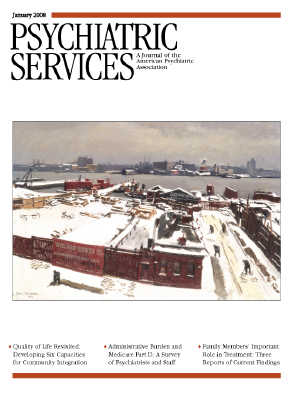January 2008: This Month's Highlights
Quality of Life as Social Integration
What is quality of life in the context of severe mental illness? A research group led by Norma C. Ware, Ph.D., seeks to go beyond the usual measures of symptoms and functioning and to reconceptualize quality of life in a way that sets higher standards and reflects the current emphasis on recovery. In the April 2007 issue Dr. Ware and her colleagues offered a new definition of community integration—one structured by connectedness and citizenship. In this issue they examine capacities needed for integration and how people develop them. As a framework the authors used the capabilities approach to human development, which construes quality of life in terms of agency, or self-directed action. Using qualitative methods, the authors analyzed data from interviews with 56 adults with psychiatric disabilities and five visits to programs that seek to foster integration. The authors identify six capacities needed for social integration: responsibility, accountability, imagination, empathy, judgment, and advocacy. They also posit five types of occasions that present individuals with opportunities to develop these capacities. The authors use brief case examples to show that occasions for capacity development can be incorporated into everyday routines of mental health care ( Original article: page 27 ).
Administrative Burden and Medicare Part D
In January 2006 Medicare Part D was implemented, and approximately two million patients with severe mental illness who were dually eligible for both Medicaid and Medicare benefits began to receive prescription drug coverage through new Medicare plans. Concerns were raised not only about patients' access to medications but also about the increased administrative burden for physicians and their staffs. Data presented by Joshua E. Wilk, Ph.D., and colleagues indicate that for every hour of direct patient care of dually eligible patients in the first four months after implementation, psychiatrists and their staffs spent, on average, an additional 45 minutes completing administrative tasks related to the transition. The greatest burden was created by drug plan features, including prior authorization and preferred drug formularies, and the care of patients who had problems filling prescriptions. The data were from survey responses of nearly 1,200 randomly selected psychiatrists, who in turn randomly selected a dually eligible patient in their care ( Original article: page 34 ).
Focus on Families
Three articles in this month's issue address the important role of families in the lives of people with severe mental illness. Amy N. Cohen, Ph.D., and colleagues report on the Family Forum, a 2006 conference sponsored by the Department of Veterans Affairs. The 40 researchers, providers, and administrators who attended the forum identified challenges to implementing family psychoeducation and reached a consensus on how best to move forward with new approaches ( Original article: page 40 ). In the second article Susan A. Pickett-Schenk, Ph.D., and her coauthors compare outcomes of 231 family members who participated in Journey of Hope, an eight-week family-led psychoeducation program, and 231 family members assigned to a waiting list. Program participants' gains in knowledge and coping skills were significantly higher and were maintained at six months ( Original article: page 49 ). In the third report Matthew J. Smith, Ph.D., M.S.W., and Jan S. Greenberg, Ph.D., present results of a survey of 136 siblings of adults with schizophrenia. Their findings indicate that early-intervention programs with families that focus on the needs of siblings may have lifelong positive effects on the quality of the sibling bond ( Original article: page 57 ).
Quality of Depression Treatment
Two studies in this month's issue assess whether patients with depression receive treatment that meets guidelines for effective care. Constance M. Horgan, Sc.D., and colleagues linked data from a national survey of 183 health plans with data from the Health Plan Employer Data and Information Set (HEDIS). The results indicate that medication treatment met criteria for 60% of patients in the acute phase and 43% in the continuation phase. On a third measure—optimal contact between the behavioral health provider and the primary care physician—only 22% of patient care met guidelines ( Original article: page 72 ). In a study of 16 primary care centers in Spain, Alejandra Pinto-Meza, Ph.D., and colleagues found that the proportion of patients receiving adequate care ranged from 21% to 25% during the acute phase and first three months of the continuation phase ( Original article: page 78 ).
Briefly Noted …
• John A. Talbott, M.D., editor emeritus of Psychiatric Services, reviews the history and current state of public-academic partnerships for a new column being introduced this month ( Original article: page 15 ).



